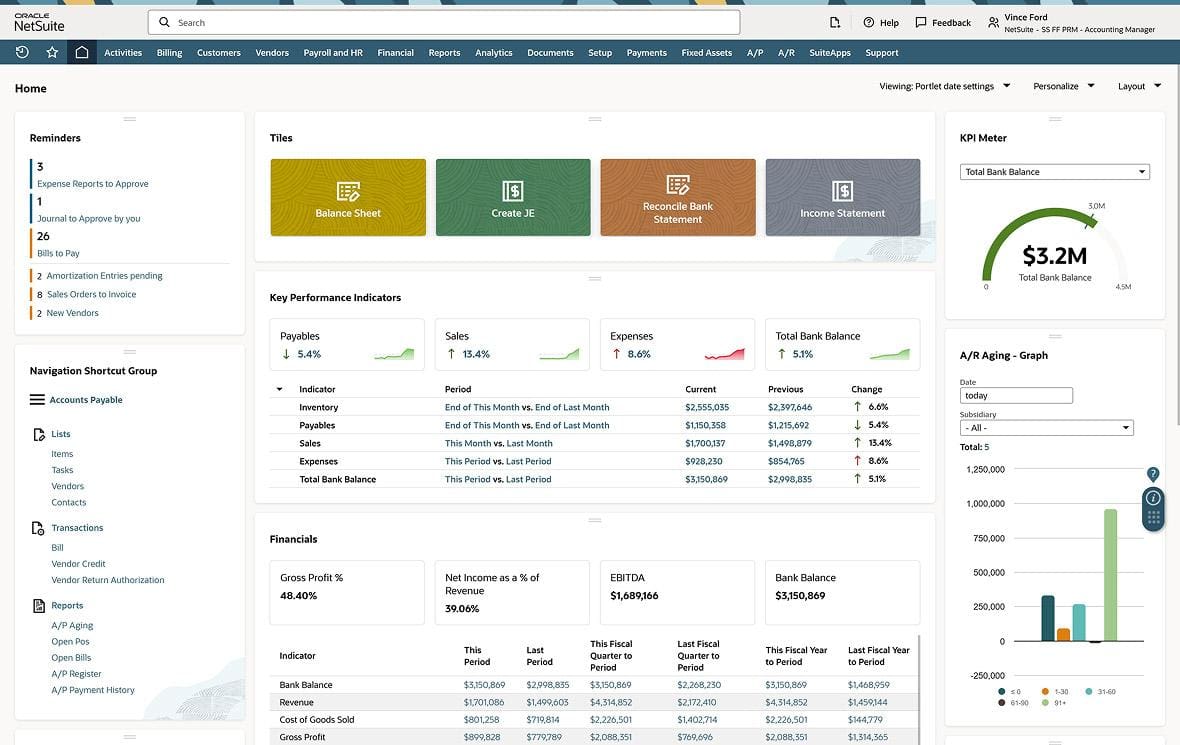Business leaders will always face difficult decisions, but artificial intelligence is helping to ease decision making by improving the data analysis that informs them. AI has already begun to transform how people analyze data. Beyond the speed at which it can generate responses to business questions, AI tools can reduce friction in the decision-making process by automating data preparation for analysis and executing steps in minutes that once took analysts many hours or days to accomplish.
This comprehensive article examines AI’s growing role in data analysis, what different AI technologies bring to the table, and the many ways companies can use AI to level up the quality of their analytics.
What Is AI in Data Analytics?
AI has been used in data analysis for several years but was, until recently, mainly the domain of big enterprises processing enormous datasets. Today, AI has become mainstream, thanks to rapid breakthroughs in large language models (LLMs) and generative AI tools.
These AI tools allow businesses to achieve quicker results, greater scale, and more accuracy than they could with earlier iterations of data analytics. They can automate parts of the resource-intensive process of gathering and preparing data for harvesting insights. As a result, with AI, data analysts are freed to perform higher-value work, including fine-tuning processes for more accurate predictive and prescriptive analyses.
For example, while time-series analysis illuminates historical trends, such as past customer transactions, adding AI capabilities allows companies to perform this analysis with greater data volumes and then make predictions or forecasts to better support decisions. Analytics tools with embedded AI capabilities can also learn as they go, making unexpected discoveries—sometimes independently of programmed queries.
Furthermore, AI enables organizations to analyze a much broader array of data types than traditional analytics tools can handle. Unlike conventional analytics, AI tools can scan structured and unstructured data, discovering previously unavailable insights in audio or video clips, for example. They let business leaders use natural language queries to help analyze unstructured data, such as social media posts, plain text, PDFs, videos, and call center recordings.
Key Takeaways
- AI can help automate tasks that ordinarily consume the valuable time of data analysts.
- AI can analyze inbound data streams to provide real-time business insights.
- Providing AI analytics tools access to company data can foster proprietary insights that generate a competitive advantage.
- A new class of autonomous and semiautonomous AI agents can be configured to perform a variety of tasks without human intervention.
Why Is AI Important in Data Analytics?
Applying AI techniques to data analytics offers more than incremental process improvements. The technology has the potential to transform how businesses obtain data insights, the speed at which they do so, and the accuracy of the results by automatically performing such tasks as identifying data patterns and anomalies without requiring programming or other forms of intervention. In addition, AI can be set up to analyze data as it streams in, fueling real-time business insights.
The LLMs behind the rapid rise of AI can be given access to an organization’s data, making it possible to apply AI analytics to proprietary information, such as customer records and sales transactions. All of this means that AI can help businesses of all sizes become more data-driven in their decision-making, fulfilling a long-sought goal. Accordingly, the technology is gaining converts rapidly. The AI analytics market is projected to grow at a 22.6% compound annual growth rate, from $29.1 billion in 2024 to $223.3 billion in 2034.
AI Technologies in Data Analytics
AI can deliver real-time business data analysis, enabling decision-makers to make quicker choices, derived from fresher data, than previously possible. AI differs from traditional data analytics in that it can process a broad spectrum of unstructured data inputs by running pattern recognition algorithms on data sources including video footage, still images, and sensor data.
Here are brief overviews of key AI technologies that can be used in data analytics.
- Generative AI: Generative AI encompasses a broad set of technologies that generate output typically based on user prompts. The most common tool is the large language model, which generates text and is discussed below. Other generative technologies generate music, images, videos, and code. In analytics, LLMs are the most commonly used technology.
- ML techniques: While most AI tools are backed by machine learning, LLMs and their generative kin go beyond classic methods of training to accomplish more advanced goals. Classic ML tools are still highly useful as they can automatically find and fix mistakes in datasets, spot anomalies, classify images and more. When given access to business data, they can play a vital role in transforming raw data into analysis-ready formats, which lowers the cost of data preparation and speeds up time to insight. ML tools also provide the technical underpinning for industry-specific tasks, such as diagnosing diseases, detecting fraud, and predicting customer churn.
- LLMs: LLMs are trained on very large text datasets and are designed to generate content for human or machine consumption. They can respond to complex user queries with accessible answers and data visualizations. Using a process known as retrieval augmented generation (RAG), they can be given access to relevant business data to help in formulating their replies. The result improves data analysts’ efficiency and accuracy by automatically creating analytics reports and running checks to identify data quality issues. In addition, a RAG-enabled LLM can identify data patterns and develop recommendations that help data teams improve data models for better analytics results. These specialized LLMs can give companies a business edge that more generalized models cannot.
- AI agents: Agents are the next step in AI automation. They use LLMs to create plans to accomplish complex tasks and can call on other tools they may need to meet a goal. They store the results of past tasks so that they can evaluate how best to solve new tasks. AI agents could send alerts to analysts about data anomalies, validate incoming data, and orchestrate data workflows. Since they can handle more complex processes and use tools, they may autonomously change how they evaluate data to provide more insightful analytics, and unlike LLMs alone, they can explain the processes they used to achieve a result.
- Natural language processing (NLP): NLP is a form of AI that focuses on understanding language as it is written or spoken. It can be used to provide analytics systems with a semantic understanding of data and user requests. In analytics, NLP would allow an executive to ask, “how did green shirts sell last month” rather than needing a data analyst to look up the relevant SKUs, write the SQL statements needed to extract data, and then perform the analysis requested.
- Retrieval augmented generation (RAG): RAG-enabled LLMs tap data sources—such as business data—to incorporate recent, context-specific data into the content-generation process, thus yielding relevant and precise results. Without RAG or a system like it, LLMs will not have access to corporate data, making them ineffectual for analytics.
- Vector data indexing: Vectors are AI-generated numeric strings that capture the semantic meaning or other features of the data—like whether a car is red or a house is colonial style. This makes it possible to perform data retrieval based on meaning, rather than on exact matches. In data analysis, vector analysis can identify content, such as articles with similar content, and RAG can then supply the data to LLMs to aid them in answering user prompts. Vector indexing can identify similar images, such as locating all two-door red sports cars in a larger dataset. Vectors can support multimodal data analysis, searching across text, images, and other datatypes.
- Similarity search: Since vectors let computers understand and process data based on semantic meaning, they can be used for similarity searches. A potential home buyer might ask to be shown all homes similar to one they like. In analytics, vector-enabled databases can be asked to return all data that is similar to a user’s query. For instance, if an executive wants to know how well green shirts are selling, vectors can be used to retrieve all data similar to “green shirts.”
Where Can AI Be Used in Data Analytics?
As datasets and LLMs grow in size and utility, AI can help manage rising data complexity and volume. AI techniques can be used in many types of analyses, helping data teams spot patterns and anomalies more efficiently—and faster—than was possible with previous generations of analytics tools. AI’s ability to strengthen real-time data analysis supports business agility and timely, data-driven decision-making. And, because AI can help automate data preparation, it can trim the operational costs of analytics and accelerate time to insights.
1. Predictive Analytics
AI can help analysts build organizational trust in data, data models, and predictive analytics results themselves by analyzing larger datasets and boosting forecast accuracy. By integrating AI into predictive analytics, analysts can better anticipate future trends, mitigate potential risks, and personalize offerings based on predictive insights. can better anticipate future trends, mitigate potential risks, and personalize offerings based on predictive insights.
2. Forecasting
AI offers analysts numerous advantages in its ability to scale, automate analyses, and process unstructured data, such as images and social media content, for improved forecasting. Some AI models can also learn and adapt to changing conditions and uncover trends and customer sentiment—inputs that are pivotal to formulating accurate demand, supply chain, and financial forecasts.
3. Sentiment Analysis
Businesses employ sentiment analysis to understand customer interactions and feedback, monitor social media, and evaluate market research. AI can help analysts to process those data inputs faster and to work with a broader array of inputs, including unstructured data, to deliver more accurate analysis. Sentiment analysis models can help marketers adjust their messaging, products, or services in keeping with shifting sentiment.
4. Customer Segmentation
Customer segmentation is a resource-intensive task that can benefit from AI-based automation. Data analysts can use AI to help them integrate data from customer relationship management and enterprise resource planning (ERP) systems, among others, to assist in segmenting customers according to factors such as spending, behaviors, and engagement. With AI-powered customer segmentation, analysts can more clearly identify high-value segments that improve the effectiveness of marketing and sales campaigns—which, in turn, enhances business performance.
5. Text Generation
LLMs can automatically generate first drafts of routine reports, easing a data analyst’s workflow so they can focus on producing higher-value insights and analyses. AI can also off-load some tasks, such as categorizing, documenting, and cataloging datasets, to improve the data’s usefulness to decision-makers. GenAI tools can analyze data and generate cogent and grammatically correct content, in bulk, and adapt that content to different writing styles and tones to suit various audiences.
6. Anomaly Detection
Data analysts employ a variety of AI models to discover deviations, exceptions, and meaningful, statistical anomalies in a dataset. ML techniques are particularly adept at such efforts. Data analysts may use custom-built anomaly recognition models that help improve fraud detection or enhance customer service initiatives.
7. Debugging and Troubleshooting
Analytics is often a work in progress, requiring data teams to adjust queries and fix data quality issues that may result in false findings. Coders and quality assurance teams employ AI tools to help them identify the root causes of data and coding errors. For example, AI tools can help prevent analytics mistakes by checking data or code before starting an analytics workload—flagging problems such as missing values in a dataset.
8. Automation
Data analysts can tame the cost and complexity of managing large analytics workloads by automating to maximize processing efficiency and prevent errors, and minimize human intervention. Organizations in highly regulated fields could employ AI automation in analytics to satisfy reporting requirements by helping analysts track metrics and write reports with data visualizations. Increasingly, automation is being applied to datasets for pattern recognition and discovering anomalies.
9. Dashboarding and Reporting
Because AI can tap a broader range of data types than earlier forms of analytics, analysts can use it to broaden the depth and scope of real-time key performance indicator (KPI) reporting. This can help businesses more closely monitor KPIs that reflect customer interactions, sales forecasting, spending, and more. As AI becomes a more integral part of data analytics, it can level up the quality of automatically generated reports—reducing the cost and complexity, for example, of satisfying multiple regulatory compliance mandates.
10. Data Visualization
Data trends are often much easier to visualize when presented in a chart rather than a table. Data analysts use visualization tools to present data in readily understood formats for business decision-makers to comprehend, share, and use quickly. AI-powered data visualization tools can help analyze data quickly, uncover patterns, and predict how trendlines might change over time.
Examples of AI Use Cases in Data Analytics
As data analysts increasingly embrace AI, they are discovering new, nontraditional ways of using data to generate business value. Here are five important ways organizations are using AI in analytics.
- Debugging code: AI-assisted coding tools can help software engineers complete their code, find bugs and suggest alternative approaches. This can be valuable for debugging data analysis scripts and improving the accuracy and reliability of analytics.
- Automated data cleansing: Fixing errors in a dataset is costly and time-consuming, yet vital for accurate results. Applying AI to fix dataset inaccuracies, such as removing duplicated information, enables analysts to spend less time on manual interventions and more time focusing on higher-end analytics functions.
- Synthetic data generation: In healthcare, protecting personally identifiable information is a federal requirement. Synthetic data—artificial data that replicates the patterns, structures, and other properties of real-world data without containing any real-world information—enables data analysts to avoid exposing sensitive information that violates privacy protection standards and requirements.
- Enhanced predictive analytics: Identifying complex data patterns through predictive modeling enables businesses to improve their mastery of high-value applications, such as demand forecasting, customer churn, and preventive maintenance. AI-enhanced predictive analytics can process larger datasets and employ more sophisticated approaches than prior forms, thus offering deeper and more precise insights than standard approaches allow.
- Insight extraction and explanation: AI-supported analytic methods that discover hidden patterns and anomalies in large datasets become even more valuable when they can render results in clear, plain language. This is especially useful in root-cause analysis, which analysts might use to ascertain the origins of system performance problems, for example, and then make timely corrections.
Leverage Embedded AI With NetSuite
Use of AI is growing because organizations want it to help boost productivity and generate insights, while their employees want it to simplify their work and lend a hand with their most arduous daily tasks. NetSuite embeds AI functionality throughout its ERP system to help meet these AI strategy objectives.
Business leaders, for example, can make faster and more informed decisions with the help of NetSuite AI Advisor capabilities. It can help them apply AI analysis to large datasets to improve forecast accuracy and add narrative commentary to reports. NetSuite AI Assistant harnesses the power of GenAI to improve invoice processing, content generation, and financial anomaly detection. NetSuite SuiteAnalytics Assistant can boost team productivity by creating reports and charts via a natural language interface.

Data analysis is an often complex and time-consuming process that is ripe for AI automation. Decision-makers know they can achieve better business outcomes if they can obtain more timely and accurate data insights, but getting there often means they must first spend time and money to clean and integrate data from disparate sources. AI can help organizations tackle those hurdles by automatically preparing datasets for analysis. The advantages don’t stop there, however. AI capabilities can enhance the quality and accuracy of analytics results and improve analytics’ teams ability to share those results in ways that make them more comprehensible for all stakeholders.
AI in Data Analytics FAQs
Is AI assisting data analysts?
AI can tackle rote data-preparation steps that until now have impeded data analysts from performing higher-value work. Businesses can use AI to help conduct statistical tests, discover patterns, anomalies, and correlations, and to detect data quality issues before data analysis begins. These uses of AI can help improve accuracy and boost data analyst productivity.
Can AI be used to collect data?
AI can turbocharge data collection, utilizing automation to prepare data for analysis. It performs once labor-intensive tasks, such as merging datasets, standardizing data formats, and data validation. AI also ingests data in other valuable ways, filtering raw data streams from Internet of Things sensors, for example, and other devices. Such live data feeds enable organizations to gain timely insights about the status of critical devices.









